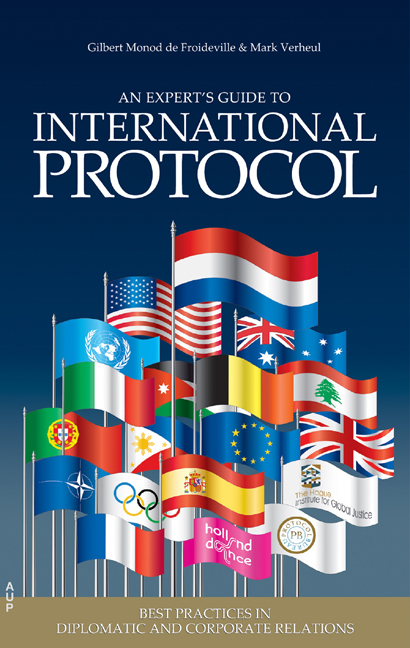Book contents
- Frontmatter
- Contents
- Preface by His Royal Highness Prince Carlos de Bourbon de Parme
- Prologue
- Acknowledgements
- 1 International Protocol
- 2 Precedence
- 3 Seating Arrangements and Order of Processions
- 4 Flag Protocol
- 5 Invitations and Dress Codes
- 6 Gifts and Honours
- 7 Ceremonies
- 8 The Protocol Officer
- 9 Guest and Host
- Authors’ Biographies
- Bibliography
- Websites
- Illustrations and Photographs
- Index
5 - Invitations and Dress Codes
Published online by Cambridge University Press: 12 December 2020
- Frontmatter
- Contents
- Preface by His Royal Highness Prince Carlos de Bourbon de Parme
- Prologue
- Acknowledgements
- 1 International Protocol
- 2 Precedence
- 3 Seating Arrangements and Order of Processions
- 4 Flag Protocol
- 5 Invitations and Dress Codes
- 6 Gifts and Honours
- 7 Ceremonies
- 8 The Protocol Officer
- 9 Guest and Host
- Authors’ Biographies
- Bibliography
- Websites
- Illustrations and Photographs
- Index
Summary
History and introduction
According to Dr Carbone's article about the history of the social invitation (2004), there is a long history to the evolution of the invitation as we know it today.
Invitations to social events were used by the aristocracy in England and France probably beginning in the 18th century. It may be possible to go back another hundred or two hundred years to find the foundations which began the tradition of the invitation. The Kings, Queens, Lords, Ladies, Dukes, Duchesses, or in today's vernacular, ‘High Society’ would invite their peers to their social events with hand written announcements of the event. These were written by the wife, butler, or secretary. Writing was a mark of education. Even after the printing press, the aristocracy hand wrote invitations since ‘mass production’ would be in bad taste.
Even though the printing press appeared in Europe in the mid-13th century, the printing of social invitations did not begin until the start of the 20th century. Some of the elite, fascinated with industrialization, began using ‘mass produced’ invitations probably as either a novelty or simply as another expression of wealth.
The real beginning of the commercially printed invitation began in the United States probably after World War II. One of the great features of the combination of democracy with industrialization is to give the common man the ability to mimic the lifestyles and materialism of society's elite. About the same time, Amy Vanderbilt and Emily Post appear on the scene to help correct the fumblings of society. The first appearance of the printed invitation was probably for large events hosted by wealthy industrialists wishing to exploit ‘new technology’.
If you and I could afford ordinary printed invitations, then the socially elite needed to distance themselves from such an abomination. They then elected to have their invitations ‘engraved’. This served a second purpose. It permitted the printed invitation to emulate handwriting since engraved copper plates were made by hand. Engraving, as the name implies, requires an artisan to ‘hand write’ in reverse into a metal plate using a carving tool. To this day, the finest invitations are engraved.
- Type
- Chapter
- Information
- An Experts' Guide to International ProtocolBest Practices in Diplomatic and Corporate Relations, pp. 125 - 164Publisher: Amsterdam University PressPrint publication year: 2016



